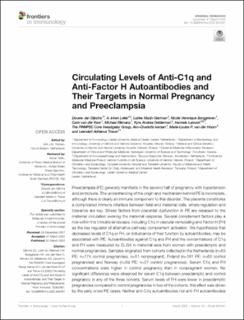| dc.contributor.author | Dijkstra, Douwe Jan | |
| dc.contributor.author | Lokki, A Inkeri | |
| dc.contributor.author | Gierman, Lobke | |
| dc.contributor.author | Borggreven, Nicole Veronique | |
| dc.contributor.author | van der Keur, Carin | |
| dc.contributor.author | Eikmans, Michael | |
| dc.contributor.author | Gelderman, Kyra Andrea | |
| dc.contributor.author | Laivuori, Hannele | |
| dc.contributor.author | Heinonen, Seppo | |
| dc.contributor.author | Kajantie, Eero Olavi | |
| dc.contributor.author | Kere, Juha | |
| dc.contributor.author | Kivinen, Katja | |
| dc.contributor.author | Pouta, Anneli | |
| dc.contributor.author | Iversen, Ann-Charlotte | |
| dc.contributor.author | van der Hoorn, Marie-Louise P | |
| dc.contributor.author | Trouw, Leendert Adrianus | |
| dc.date.accessioned | 2023-01-31T15:35:57Z | |
| dc.date.available | 2023-01-31T15:35:57Z | |
| dc.date.created | 2022-05-16T16:02:43Z | |
| dc.date.issued | 2022 | |
| dc.identifier.citation | Frontiers in Immunology. 2022, 13 842451-?. | en_US |
| dc.identifier.issn | 1664-3224 | |
| dc.identifier.uri | https://hdl.handle.net/11250/3047497 | |
| dc.description.abstract | Preeclampsia (PE) generally manifests in the second half of pregnancy with hypertension and proteinuria. The understanding of the origin and mechanism behind PE is incomplete, although there is clearly an immune component to this disorder. The placenta constitutes a complicated immune interface between fetal and maternal cells, where regulation and tolerance are key. Stress factors from placental dysfunction in PE are released to the maternal circulation evoking the maternal response. Several complement factors play a role within this intricate landscape, including C1q in vascular remodeling and Factor H (FH) as the key regulator of alternative pathway complement activation. We hypothesize that decreased levels of C1q or FH, or disturbance of their function by autoantibodies, may be associated with PE. Autoantibodies against C1q and FH and the concentrations of C1q and FH were measured by ELISA in maternal sera from women with preeclamptic and normal pregnancies. Samples originated from cohorts collected in the Netherlands (n=63 PE; n=174 control pregnancies, n=51 nonpregnant), Finland (n=181 PE; n=63 control pregnancies) and Norway (n=59 PE; n=27 control pregnancies). Serum C1q and FH concentrations were higher in control pregnancy than in nonpregnant women. No significant differences were observed for serum C1q between preeclamptic and control pregnancy in any of the three cohorts. Serum levels of FH were lower in preeclamptic pregnancies compared to control pregnancies in two of the cohorts, this effect was driven by the early onset PE cases. Neither anti-C1q autoantibodies nor anti-FH autoantibodies levels differed between women with PE and normal pregnancies. In conclusion, levels of anti-C1q and anti-FH autoantibodies are not increased in PE. C1q and FH are increased in pregnancy, but importantly, a decrease in FH concentration is associated with PE. | en_US |
| dc.language.iso | eng | en_US |
| dc.publisher | Frontiers Media | en_US |
| dc.rights | Navngivelse 4.0 Internasjonal | * |
| dc.rights.uri | http://creativecommons.org/licenses/by/4.0/deed.no | * |
| dc.title | Circulating Levels of Anti-C1q and Anti-Factor H Autoantibodies and Their Targets in Normal Pregnancy and Preeclampsia | en_US |
| dc.title.alternative | Circulating Levels of Anti-C1q and Anti-Factor H Autoantibodies and Their Targets in Normal Pregnancy and Preeclampsia | en_US |
| dc.type | Peer reviewed | en_US |
| dc.type | Journal article | en_US |
| dc.description.version | publishedVersion | en_US |
| dc.source.pagenumber | 842451-? | en_US |
| dc.source.volume | 13 | en_US |
| dc.source.journal | Frontiers in Immunology | en_US |
| dc.identifier.doi | https://doi.org/10.3389/fimmu.2022.842451 | |
| dc.identifier.cristin | 2024959 | |
| dc.relation.project | EC/H2020/724517 | en_US |
| dc.relation.project | Norges forskningsråd: 223255 | en_US |
| cristin.ispublished | true | |
| cristin.fulltext | original | |
| cristin.qualitycode | 1 | |

